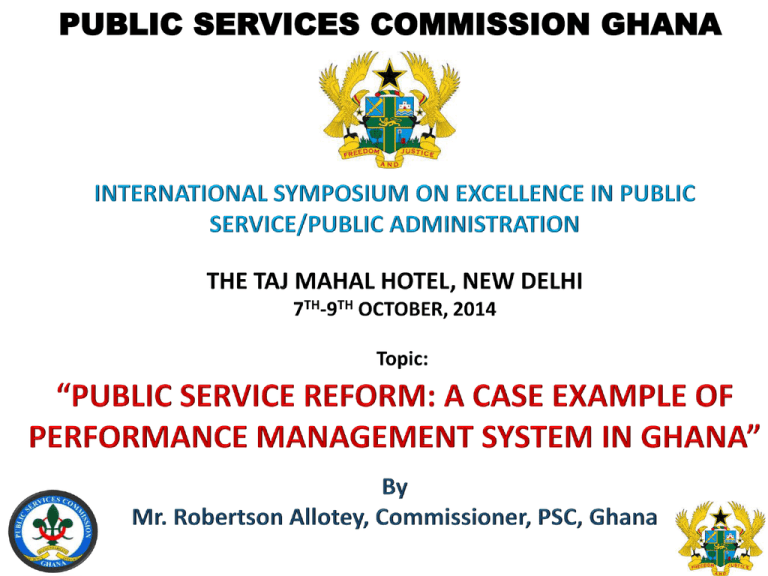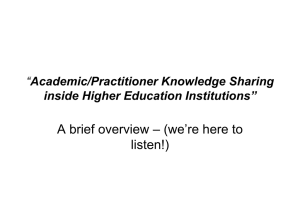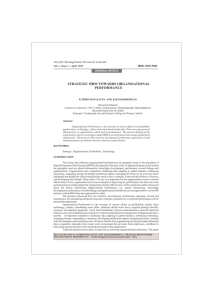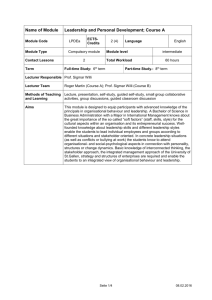Presentation - Department of Administrative Reforms and Public
advertisement

PUBLIC SERVICES COMMISSION GHANA 1 INTRODUCTION Ghana over the last three decades, has undertaken several reforms in the public sector, designed mainly to improve the efficiency and effectiveness of service delivery to enhance productivity. One of the initiatives has been the desire to establish a performance management system based on an effective performance management culture that seeks to sustain an effective performance culture that sets objectives, targets and aligns staff performance to organisational and national development goals The PSC is the lead agency in championing Reforms specific to HRM and practices. The following initiatives have been embarked on concurrently; HRM Policy Framework and Manual; Performance Management System; HRM Information System; Corporate Governance and Capacity Building System and Annual State of the Service Report. 2 CHALLENGES OF THE EXISTING SYSTEM • In the area of performance management, a number of initiatives have been undertaken to establish an effective performance management culture that seeks to align objectives, targets and outcomes to organizational and national development goals. • These included the following: Annual Confidential Reporting System (ACRS) which was reviewed in 1974; Performance Evaluation System (PES) introduced in the Public Service in 1992 under the Civil Service Reform Programme (CSRP) -1987 – 1993. In 1997 a Performance Agreement System (PAS) was introduced to provide an objective means of assessing the performance of Senior Managers and Chief Directors (CDs) in the Ministries and the Regional Coordinating Councils (RCCs). 3 CHALLENGES OF THE EXISTING SYSTEM (Cont.) • Absence of a clearly defined, articulate and enforceable implementation framework; • low Executive commitment/involvement and support for the PMS in contrast to what pertains in other developed/developing countries; • poor understanding of the roles of Governing Boards/Councils in the Appraisal system; • absence of rigour, objectivity and continuity in the administration of the system; • non-linkage of the process to an enforceable Reward and Sanctions Mechanism; ignorance of Public Servants on the merits of PMS; • non-linkage of the system to staff development, i.e. training and career development; and lack of effective monitoring and annual reporting and feedback mechanisms. 4 ADVERSE EFFECTS ON PRODUCTIVITY • non-responsiveness/adherence to Staff Performance Appraisal System/Performance Agreement; • poor performance reporting system and non-compliance to timeliness/deadlines; and • weak supervision, breakdown in discipline and work ethic. Productivity was difficult to measure while the general public’s perception on the output of public servants was poor. Clearly there was the need for a paradigm shift in the existing conceptualization and the underlying philosophical principles. 5 PARADIGM SHIFT: CONCEPTS AND PRINCIPLES • In the conceptualization of the New Performance Management Policy Framework four key principles were adapted. These principles of Accountability, Transparency, Equity and Ownership, theoretically, were considered as the building constructs to guide the development of the policy statements/guidelines, the Performance Management System, as well as the assessment instruments and tools which were all home-grown initiatives. • The New Performance Management System encapsulates the underlying principle that performance is an on-going process that takes place from the time an employee joins the organisation until they leave and should be used in that time to support and develop people through their employment with the organisation. 6 POLICY STATEMENTS/GUIDELINES • Performance Management (PM) shall be a management tool for meeting organisational goals • Performance Management shall be used to create a shared understanding of what is to be achieved and how it is achieved. • Performance Management shall be viewed both as an approach and a system for managing people and other organisational resources. • Competencies and measurement standards shall drive the performance management process to achieving desired results. • Performance Management shall drive the process through clear, consistent, visible and active involvement of the governing bodies, senior executives and managers. • Management and staff shall adopt effective and open communication systems at all levels for the successful promotion of the performance management process. • Incentives, rewards, recognition and sanctions shall be linked to performance. • Performance results and progress shall be openly shared/communicated with employees, customers, and stakeholders 7 Prescriptive in nature – concentrates on what has to be • achieved Interest is in the individual’s past. • Seen by staff and managers as a year meeting • • • Top down approach – one way assessment by the • Manager / supervisor One- way communication flow • Normative – hinges on how to make it more likely that it will be achieved Emphasizes on how staff should operate It is a continuous process throughout the year informally and formally through review meeting at three monthly or six monthly intervals Top down and bottom up approach – helps managers /supervisors to ensure corrective measures before something goes wrong Two –way communication flow Reliance on how far the individual has met the tasks of job Concerned with what an individual does and how they do it descriptions as in the appraisal Usually concentrates on past results • • Individuals asked to choose the training they would wish to • undertake • Reviews past results for both positive and problematic areas Concentrates on identifying and agreeing with the individual’s achievements for the next period Concerned with establishing a coaching relationship between the Manager /Supervisor and the individual. Staff feel supported and motivated whilst the learning they undertake is appropriate, relevant and of use in their work, thereby enhancing their performance and contribution to the organizational goals 8 PERFORMANCE MANAGEMENT CYCLE 1. Planning • Define role & responsibilities • Communicate corporate vision and strategic plan • Set Functional and individual objectives aligned to the vision • Identify competencies & required behaviours 4. Recognising &Rewarding • Reward excellent 2. Progress Reviews performance • • Performance Management cycle Decide on steps to develop skills and competencies (e.g. PiP) • Monitor & evaluate performance against objectives- linking the objectives and Agree sanctions where competencies being necessary demonstrated 3. Appraisal • Appraise individual, reflect upon past performance & provide evidence based feedback • Review individual’s strengths and identify development areas 9 GOVERNANCE STRUCTURES AND MONITORING MECHANISMS FOR SUSTAINANBILITY • To ensure the sustainability of the system a governance regime/structure has been introduced. This was all inclusive capturing the overarching roles, responsibilities, authority relationships of the major stakeholders. This included: Public Services Commission, Governing Councils and Boards, Heads of the Public Services/Chief Executives/ Chief Directors, Ministry of Finance and Economic Planning, the National Development Planning Commission and the Fair Wages and Salaries Commission. • The Pubic Services Commission has been the lead agency in the development and management of the new performance management system in Ghana. All relevant public service institutions including the Universities and Management Development Institutes were involved, consulted and bought-in into the new system. The funding was strictly from the Public Services Commission annual budgetary support from government. External technical assistance was also provided by the Australian Public Service Commission as part of its Africa Programme for improving Public Administration practice. 10 10 WHAT IS NEW? • Recognition that PM is an ongoing process that takes place from the time the employees join the organisation until they leave. Employers should, therefore, support and develop peoples through their engagement in the organizations. • Performance driven culture through the process approach i.e. an all inclusive top-down and bottom-up approach to PM. • Institutionalisation of a Rewards and Sanctions regime in the public service of Ghana. • Positioning and strengthening the HR function to play a strategic role in HRM practice in public service agencies. • A system for communicating (two-way flow) National Development Goals and Organisation’s Goals and Values to employee job functions to ensure relevance of the Organisations themselves. In effect there is to be the linkage with the National Goals/Organisational Goals/Departmental Goals and individual objectives to ensure the necessary synergy for development. • People development a key driver to ensuring high productivity at all levels through continuous learning and training. • Recognition that the often ignored soft issues in HRM performance assessment i.e. the competencies and skills employed by the individuals 11 must be measured and assessed objectively. EXPECTED OUTPUTS AND BENEFITS The new System, has the following expected outputs and benefits:• enables the Public Service to attract and retain talent; • leads to significant improvement in performance and customer sensitivity among Public Servants; • promotes professionalization of the HR Management in the entire Public Service for improved management of staff; • offers equal opportunities, for progression on merit and recognition for all sexes, ethnic backgrounds, occupational groups and grades; while ensuring high morale amongst public servants; • contributes to higher productivity, strengthens the ability of the public service to create the enabling environment for private sector operations and attainment of Millennium Development Goals; • lead to improved customer sensitivity and responsiveness; and • public satisfaction with the services of the Public Service Institutions shall be greatly enhanced. 12 12 CONCLUSION • The new initiatives being introduced are meant to strengthen the capacity of public servants to discharge their duties and responsibilities efficiently and effectively. They are largely home-grown and are the result of careful assessment and review of the current state of HRM and its effectiveness for national development. “The Central focus of public sector reform rightly remains the transformation of the conditions of employment of career public officials, who occupy key positions in government organizations, so as to enable public authorities to attract, retain and reward talented professional, and make them more responsive to citizens’ need and expectation. Once the citizen see the evidence of administrative reform in the form of improvements in service delivery and administration, the virtuous cycle of political acceptance and effective implementation will gain momentum” ( “The Specificity of Public Service Reforms”, Public Administration and Development, Vol. 24, 2004:383) 13 14 QUESTIONS, ANSWERS AND CONTRIBUTIONS 15











